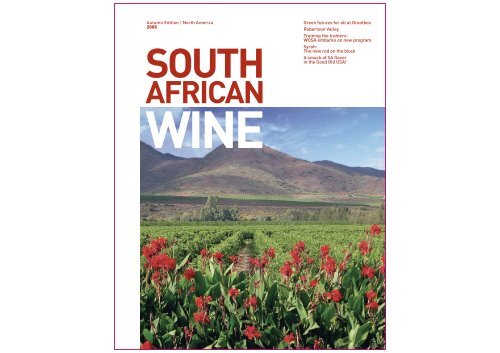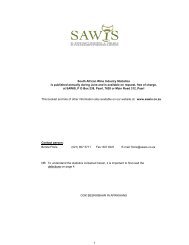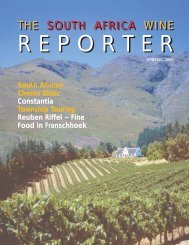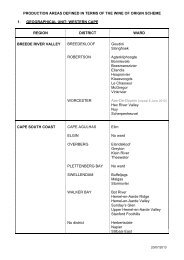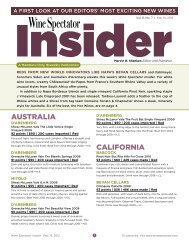30100350 SA Wine Magazine FA - Wines of South Africa
30100350 SA Wine Magazine FA - Wines of South Africa
30100350 SA Wine Magazine FA - Wines of South Africa
You also want an ePaper? Increase the reach of your titles
YUMPU automatically turns print PDFs into web optimized ePapers that Google loves.
<strong>South</strong> <strong>Africa</strong>n <strong>Wine</strong>North AmericaAutumn Edition20051. One <strong>of</strong> the lodges at Grootboswith its contemporary styleappeals to the cosmopolitantraveler. Feel welcome at a trulyunique place where conservationand relaxation have found theperfect home.THE RIGHT WHALE (Eubalaene australis)was so named because it was consideredto be the 'Right' Whale to catch. There arean estimated 3000 - 4000 <strong>South</strong>ern RightWhales in the world, the majority <strong>of</strong> whichannually visit the <strong>South</strong> <strong>Africa</strong>n coastlinefrom May to December.3‘If you don't smile from the heart,don't bother pulling your face– it must be for real,’ says RichardGosa, head barman at Grootbos.This simple and subtle commentclearly reflects the Grootbosphilosophy, instilled by owner,Michael Lutzeyer.Green futures for allGROOTBOS1.2.4.3.The fundamentals <strong>of</strong> this mentality arerooted in the very soil <strong>of</strong> this propertybecause Grootbos is a conservancy <strong>of</strong>1 768ha, protecting a unique part <strong>of</strong> theCape Floral Kingdom (CFK), with fynbosas the focal point. Lutzeyer has created adestination that encapsulates not onlybrilliant service but also an environment<strong>of</strong> conservation and skills development.Grootbos is not only a reserve where a widevariety <strong>of</strong> indigenous flora is being protectedagainst property developments oragricultural eradication, it’s also a reserve<strong>of</strong> new discoveries - last year's researchrevealed no less than four previouslyunknown species <strong>of</strong> fynbos. The CFKcontains over 9 600 different plant species(this is more than the entire northernhemisphere) and has historically beenoverlooked and under-estimated. Botanistshave been researching plants in thefurthermost corners <strong>of</strong> the earth, whileacknowledgement <strong>of</strong> the WesternCape’s wealth <strong>of</strong> fynbos and renosterveldis fairly recent.Arriving at Grootbos one late afternoon inMay, we were met by possibly one <strong>of</strong> themost beautiful sunsets we've ever seenunder <strong>Africa</strong>n skies. Even without adramatic sunset, the views sweep fromvast expanses <strong>of</strong> ocean, across to CapePoint and Table Mountain. On a clear dayyou can even see <strong>South</strong>ern Right Whales(season is May - December).It was announced that one <strong>of</strong> the activitiesthe next morning, would be a game drive.This is not the normal <strong>Africa</strong>n game drivewith perhaps a lion-kill thrown in for addedexcitement, rather this is a drive aboutNature’s more subtle nuances, its aboutthe sugar bird, a rare tortoise and theindigenous plants that appear nowhereelse in the world. This is a whole differentexperience with highly trained guides, whospeak so convincingly about a flower thesize <strong>of</strong> a dragonfly that they unfold anunknown world to all who listen.‘Plants are not cute and cuddly, like babyseals; they serve as the global breathingsystem,’ says Lutzeyer. ‘We've ignored theimportance <strong>of</strong> plants for too long.’And beyond the reserve's borders? TheLutzeyer family's unselfish attitude to theirenvironment stretches into the surroundingcommunity. Grootbos is home to a school,where students are selected from thelocal township. Candidates are 18+, andcome from historically disadvantagedbackgrounds. Of 90 potential applicantsper annum, only 10 are selected to followa Life Skills course which includeshorticulture (plants are taught by their Latinnames), advanced gardening, computerliteracy, drivers' licenses at different levels,meals as well as a weekly allowance. It'stherefore no wonder that environmentaland social responsibility champions Valli2. The Cape Floral Kingdom is one <strong>of</strong> akind. Nowhere else is plant life morediverse. Grootbos Nature Reserveconserves 1 700 hectares <strong>of</strong> pristinefynbos, the Cape’s unique vegetationtype. The expert botanical guides willopen your eyes to the intricacies <strong>of</strong>the fynbos ecosystem including morethan 650 species <strong>of</strong> indigenous plantsfound on the property.3. Discover the fascinating relationshipsbetween the insects, birds, mammalsand flowering plants <strong>of</strong> this diverseecosystem. Young and old can explorethis natural wonderland on foot orby four-wheel drive vehicle.4. The cliffs <strong>of</strong> Walker Bay, right atour doorstep, <strong>of</strong>fer the bestland - based whale viewing in theworld. Watch spellbound as cows,calves and bulls come to within 30metres <strong>of</strong> the rocky shoreline.Moosa and Kader Asmal support theproject. Grootbos is an excellent example<strong>of</strong> how the private sector is embracingblack economic empowerment (BEE),specifically on the skills transfer level.It is also not surprising, then, that theUK-based Eden Project commissionedGrootbos to manage and maintain theirFynbos Dome in London. Each year, thisproject receives three Grootbos-trainedguides to convey to visitors their homegrownpassion and knowledge <strong>of</strong> the CFK.Among others, this project has attractedthe interest and support <strong>of</strong> Princess Annand the National Geographic Society.‘Grootbos <strong>of</strong>fers a unique experience,blending 5-star luxury with a world-famousfynbos reserve, slap bang in the middle <strong>of</strong>the Cape winelands, 15 minutes from thebest land-based whale watching in theworld,’ Lutzeyer continues.Logistically, Grootbos is a two-hour leisurelydrive from Cape Town International Airport,15 minutes from the burgeoning Stanfordwineries (Raka and Jackson's), half an hourfrom the Walker Bay wineries in the Hemelen Aarde Valley (which include internationallyacclaimed Hamilton RussellVineyards, Bouchard Finlayson and others).An ideal schedule would be to plan anafternoon arrival with a midday departurethe following day, which would <strong>of</strong>fer ampletime to enjoy the region's wine farms,whale watching as well as the Grootbosexperience. Grootbos <strong>of</strong>fers breakfast,lunch and dinner, nature walks, drives andeducationals. The Lodge is divided intoGarden and Forest sections, with a totalcomplement <strong>of</strong> 20 rooms.Visit www.grootbos.co.za for further details,visuals and on-line bookings.André MorgenthalWO<strong>SA</strong> Communications Manager
<strong>South</strong> <strong>Africa</strong>n <strong>Wine</strong>North AmericaAutumn Edition2005It’s coming up <strong>Wine</strong> and Roses in theRobertson photos kindly supplied by the Robertson <strong>Wine</strong> Valley marketing <strong>of</strong>ficeROBERTSON6VALLEYKnown as the Valley <strong>of</strong> <strong>Wine</strong> and Roses, Robertson also features warm hospitality and valuefor money. The valley’s wine producers have transformed this area from a region knownfor producing inexpensive everyday whites to one which is attracting national andinternational accolades for a diverse range <strong>of</strong> quality wines.MYRNA ROBINS ELABORATESThis fair valley forms the eastern end <strong>of</strong> the long, broad BreedeRiver Valley, <strong>of</strong> which wine region it is also part. Lying about 160km- almost due east and inland from Cape Town – it’s a warm, dryarea, with an average altitude <strong>of</strong> 181 metres. It’s also a zone thatbridges the gap between the verdant, populous Boland and thesemi-desert terrain <strong>of</strong> the comparatively isolated Karoo.Travelers taking the R60 from Worcester to Robertson will whizzalong a new highway where indigenous bush gives way to vineyardsinterspersed with paddocks and pastures, followed by orchards <strong>of</strong>deciduous fruit that march between groves <strong>of</strong> silver-leaved olives.For, while wine comes first, peaches, apricots and fine stud farmsall play an economic role here, with ostrich and dairy farms furthercontributing to agricultural diversity.The town <strong>of</strong> Robertson, with its backdrop <strong>of</strong> the mauve andmajestic Langeberge (long mountains) makes the central focus,with the villages <strong>of</strong> McGregor, Bonnievale and Ashton in the vicinity,all <strong>of</strong> which also look to tourism as a source <strong>of</strong> income.The wine district <strong>of</strong> Robertson is divided into 10 smaller productunits, or wards. There are around 47 cellars in all, comprising agood mix <strong>of</strong> long-established estates and co-operatives, large andsmall, along with several boutique wineries and a handful <strong>of</strong>garagistes. Across the region, rainfall averages range between alow <strong>of</strong> 150mm and a high <strong>of</strong> 321mm. Summer day temperaturesaverage 28,6ºC, dropping to 14,1ºC at night. In winter it rangesfrom a daytime high <strong>of</strong> 21,1ºC to a night low <strong>of</strong> 7,4ºC.For decades the Robertson valley has been known for enjoyable,easy-drinking affordable whites and good fortified Muscats,both red and white. Heat-tolerant Chenin Blanc and Colombardwere the most popular cultivars, delivering guava-scented, dryor <strong>of</strong>f-dry wines. The best among them made – and still make– delicious summery aperitifs, meant to be enjoyed young.While the Breede river provides some irrigation, the building <strong>of</strong>the large artificial Lake Marais – known locally as the BrandvleiDam – over marshland near Worcester in 1923 improved theviability <strong>of</strong> wine grape cultivars. The capacity <strong>of</strong> the dam wasincreased in 1950 and a network <strong>of</strong> canals leads this life forcefrom the Worcester wine area into sections <strong>of</strong> the Robertson valley.The resurgence and expansions <strong>of</strong> the Cape wine industry since1990 were reflected in this region by developments that areproving far-reaching indeed. During the last decade <strong>of</strong> thecentury scientific plantings <strong>of</strong> Chardonnay, Sauvignon Blancand some Gewurztraminer replaced some <strong>of</strong> the old workhorsecultivars <strong>of</strong> Chenin and Colombard. This investment led to aleap in quality that has placed Robertson on the vinous map asa producer <strong>of</strong> fine whites from classic cultivars, with SauvignonBlanc and Chardonnay heading the list. This was matched by amove to red, as farmers instigated intensive research on matching<strong>of</strong> cultivar to suitable site before planting, using global expertise,including that <strong>of</strong> Californian fundis.Early releases are demonstrating that Shiraz is likely to be thenumber one winner here, with some Cabernet Sauvignons showinggreat promise, while Merlot and Pinotage are not far behind.Myrna Robinshas worked with the Cape Argusfor over a decade, contributing tothe wine and food sections amongothers. She has published four books in<strong>South</strong> <strong>Africa</strong> and one in theUnited Kingdom. Her most recent book,Cape Flavour, is a gastronomicmeander through 12 Cape wineregions, highlighting wine and culinarystyles, beautifully photographed.www.robertsonwinevalley.com
Autumn Edition2005TRAINING THE TRAINERS7 8ROBERTSONVALLEYSOCIAL RESPONSIBILITYThe <strong>Wine</strong> Industry in Robertson tackles socialresponsibility issues with the same passion thatit pours into its wines. Among other programs,in 2003 a rural development program was startedin the valley, known locally as LOVE, which nameis derived from the initials <strong>of</strong> its <strong>of</strong>ficial Afrikaanstitle, Landelike Ontwikkelsings Vennote. Thispartnership, between farm-workers, wine cellars,commercial farmers and municipalities embracesa comprehensive list <strong>of</strong> aims and objectives aroundoverall goals <strong>of</strong> upliftment and empowerment.Leaders among workers have been identified andthis resulted in the establishment <strong>of</strong> a number <strong>of</strong>adult education classes, sporting fixtures andstocking <strong>of</strong> school libraries in the more isolatedareas. New day - care facilities are beingestablished, more health workers trained and theprogram is expanding rapidly.FIVE YEARS INTO THE NEW MILLENNIUMAND WHAT DO WE FIND?Statistics (published last year) reveal thatsome 44 370 000 vines cover around 12 770hectares, making Robertson home to about11,5% <strong>of</strong> the total area under vine in <strong>South</strong><strong>Africa</strong>. Sauvignon Blanc, Chardonnay and CapClassique are the signature whites, withShiraz and Cabernet Sauvignon the top reds.In 2003 the percentage <strong>of</strong> white wine varietiesto red stood at 64,3% to 35,7%.CELLARS OF NOTEWhile it is always difficult to single out cellars from a diverse group whose personnelare passionate, dedicated and quality-driven, a few names that play exceptionalroles should be identified.Starting with bubbly, the right prelude to any significant event: Here GrahamBeck <strong>Wine</strong>s is the undisputed star in the Robertson valley, producing successivevintages <strong>of</strong> superb Cap Classiques. The ’99 Blanc de Blancs, made from Chardonnay,made Decanter’s Top 20 <strong>South</strong> <strong>Africa</strong>n list. The popular Brut combines Chardonnaywith 46% Pinot Noir. <strong>Wine</strong>maker Pieter Ferreira wears his nickname Bubbles withmodest pride and this ultra-modern winery is widely regarded as one <strong>of</strong> the fourmost exciting in <strong>South</strong> <strong>Africa</strong>.Springfield Estate, a long-established farm on the Breede river banks, is another<strong>of</strong> this quartet. Here Abrie Bruwer has expressed his innovative non-conformisttalent for winemaking since 1995 with a series <strong>of</strong> brilliant Sauvignon Blancs,Chardonnays and Cabernet Sauvignons. Minimal interference, traditional methods,long fermentation using native wild yeasts and whole berry wine - making areamong processes tried and tested. The new millennium saw the release <strong>of</strong> a classicCabernet Franc, Merlot, Cabernet Sauvignon and Petit Verdot blend that hasattracted rave ratings from connoisseurs.The local ‘King <strong>of</strong> Chardonnay’ also resides in the Robertson valley – and hiscontribution to the industry and its people extends far beyond this cultivar. Daniede Wet <strong>of</strong> De Wetsh<strong>of</strong> Estate startled the Gallic world when his ’85 vintageChardonnay was judged as the world’s best at France’s prestigious Vinexpo. Todayhe produces top quality Chardonnays in varying styles even as he continues to servethe industry in <strong>of</strong>ficial and demanding posts at a time <strong>of</strong> huge political change.Chardonnay is also a wine not to be missed when visiting Weltevrede Estate andtheir sparkling wine is becoming a force to be reckoned with as well. This is anotherlong-established farm with present winemaker Philip Jonker following in his father’sfootsteps by taking a leadership role as chairman <strong>of</strong> the local tourism initiative.While good Shiraz can be tasted at many a Robertson cellar today, it was thevenerable cellar (and stud farm) Zandvliet that first produced exciting quality winesfrom this cultivar.Given the talent, dedication, passion and commitment <strong>of</strong> Robertson winemakers,viticulturalists, farmers and marketers, this warm and welcoming area seems setfor ever greater heights in the competitive New World <strong>of</strong> wine. Proprietor andwinemaker <strong>of</strong> Springfield Estate, (and pilot, passionate fisherman and occasionalphilosopher) Abrie Bruwer sums up Robertson’s achievements like this: ‘Our valleyhas broken free from its former cocoon <strong>of</strong> isolation thanks to just one fundamental– exceptionally good wine, which has become the pride <strong>of</strong> all. Our success wasearned the hard way, but now the future is ours – this is just the beginning.’WO<strong>SA</strong> embarks on a new programPeter HellmanOne recent evening, I went to Aquavit,on Manhattan’s East Side, for theintroduction <strong>of</strong> a new ultra-premium redwine from one <strong>of</strong> <strong>South</strong> <strong>Africa</strong>’s finestwineries. The wine was splendid. My onlyproblem was that, try as I might, I couldnot properly pronounce the winery’sAfrikaans name. Its three aspirantsrefused to roll <strong>of</strong>f my tongue. Orrather, out <strong>of</strong> the back <strong>of</strong> my throat.I don’t raise the pronunciation issue to suggestthat any <strong>South</strong> <strong>Africa</strong>n winery adapt toAmerican tongues, any more than that theirBurgundian or German counterparts ought to‘streamline’ such vineyard names as Bienvenues-Bâtard-Montrachet or Karthäuserh<strong>of</strong>berg. It’sour problem, not theirs, and unease withforeign languages is practically an Americanbirthright. But naming issues are a jumping<strong>of</strong>f point to suggest that it’s not enough for<strong>South</strong> <strong>Africa</strong>’s wines to be competitive and insome categories superior, to other wines in acrowded market place. Too many consumersremain unfamiliar with <strong>South</strong> <strong>Africa</strong>’s placeon the globe, its wine country and its recentpolitical history. In short, they don’t know<strong>South</strong> <strong>Africa</strong>. Neither do most retail salespeople,waiters or for that matter, distributors’ salesstaff who are charged with selling the wines.It’s a problem <strong>of</strong> education.Enter now, on behalf <strong>of</strong> <strong>Wine</strong>s <strong>of</strong> <strong>South</strong> <strong>Africa</strong>,Robin Kelley O’Connor, former apprenticewinemaker, current president <strong>of</strong> Society <strong>of</strong><strong>Wine</strong> Educators, long-time emissary <strong>of</strong>Bordeaux wines and master communicator<strong>of</strong> wine values to the trade. O’Connor hasaccepted a mandate from WO<strong>SA</strong> to providenationwide educational seminars beginningin late summer, called ‘Training the Trainers.’‘The goal,’ says O’Connor, ‘is to put <strong>South</strong><strong>Africa</strong> into the consciousness <strong>of</strong> the trade,restaurant wine staff and culinary schoolstudents. We want to start to educate thetrade to understand that <strong>South</strong> <strong>Africa</strong> is aplace with real wines, real people and a realquality agenda.’ That knowledge can thenbe transmitted ‘downstream’ to retail wineshop managers, salespeople on the floor,restaurant servers and finally to the consumer.Why not ‘train the consumer’ directly?‘Because, we just don’t have enough time inthe year to be in as many places as thedistributor’s staff can be,’ answers O’Connor,who spent two weeks in <strong>South</strong> <strong>Africa</strong>n winecountry earlier this year. ‘In the long term, ifyou <strong>of</strong>fer a modicum <strong>of</strong> education to thesales staff, they will be our greatestambassadors. With just a little knowledgeand a few key facts in their pocket, thesepeople can spread the gospel that <strong>South</strong><strong>Africa</strong> is a country on the march. So the basicmessage is, jump in while prices are right andbecause the quality is really good.’Other emerging wine-exporting nations mighttrumpet a similar message, but <strong>South</strong> <strong>Africa</strong>has particular reasons to be heard from. ‘Abig challenge is that hardly anyone knowswhere <strong>South</strong> <strong>Africa</strong> actually is,’ says Ken Onish,president <strong>of</strong> importer <strong>South</strong>ern Starz. Onething training the trainers can do is to makesome corollaries between <strong>South</strong> <strong>Africa</strong> andCalifornia. When Americans learn that <strong>South</strong><strong>Africa</strong>’s wine country is the equivalent <strong>of</strong>being between Los Angeles and Santa Barbara,that makes them feel better.’‘One <strong>of</strong> the things that was painfully obviousto me when I started out,’ says importer PeterMorales, president <strong>of</strong> 57 Main Street <strong>Wine</strong>Co., ‘was that <strong>South</strong> <strong>Africa</strong> was one <strong>of</strong> theareas <strong>of</strong> the world producing the best wine,and yet it was totally omitted from theliterature due to the political situation thatexisted then. Even though new texts rectifythat, there is still a great gap.’Robin O’Connor started a Bordeaux educationprogram in the late 1980s, a time when hesays, ‘three quarters <strong>of</strong> the sales force werewhisky salesmen who were forced to sellwine. Several <strong>of</strong> the top 10 nationaldistributors went out <strong>of</strong> business becausethey couldn’t get their salespeople to learnthe wine story.’ O’Connor feels that it’s notthat way any more. ‘At the distributor level,’he says, ‘anyone who is thinking about gettingahead is pretty keen on education. So I feelI can get in there and start establishing someallies for <strong>South</strong> <strong>Africa</strong>n wines.’Peter Hellman writes for The New YorkTimes, Wall Street Journal, <strong>Wine</strong> Spectator,Food & <strong>Wine</strong> and other publications. Hiscolumn ‘Urban Vintage,’ appears everyWednesday in the New York Sun.
<strong>South</strong> <strong>Africa</strong>n <strong>Wine</strong>North AmericaAutumn Edition2005John Frederick Walker writes on wine, wildlife and adventuretravel for Saveur and National Geographic Traveler among others.SYRAHIThe new red on the blockBy John Frederick Walkerconfess I'm a late convert to <strong>South</strong> <strong>Africa</strong>nSyrah (or Shiraz, as some like to label it).I've always been a fan <strong>of</strong> the grape andadmittedly, the best examples I initially cameacross on visits to the Cape were full <strong>of</strong> theripe, berry-like fruit and peppery spice thatare hallmarks <strong>of</strong> first-class Syrah. So whatwas my problem? I persisted in thinking theywere one-<strong>of</strong>fs, exceptions, stunt wines - notthe harbingers <strong>of</strong> what may ultimately turnout to be <strong>South</strong> <strong>Africa</strong>'s best red.<strong>Wine</strong> journalists like to keep thingsunderstandable. If they can get a handle on awine region, they can explain it to their readers.I wasn't purposely trying to pigeonhole theCape as a wine region but on my first tourI found other grapes that seemed to bestexpress that wonderful tension <strong>of</strong> fruit andminerality that gives <strong>South</strong> <strong>Africa</strong>n wines theirspecial style. Among whites, I was drawn tothe tart, pinpoint brilliance <strong>of</strong> numerousSauvignon Blancs and among reds, the Médoclikeproportions and suppleness <strong>of</strong> the bestCabernet-based blends. I also developed apassion for the intensely brooding, barelytamedcharacter <strong>of</strong> better Pinotage.So when winemakers would press a glass <strong>of</strong>another varietal in my hand, I was curious but<strong>of</strong>ten a bit dubious. You can't do everythingwell, I'd think. None the less, I encounteredexamples <strong>of</strong> old bush vine Chenin Blanc thatforced me to scribble superlatives in mynotebook. And the handful <strong>of</strong> startlinglyseductive Pinot Noirs I came across instantlycaptivated me (there's never enough PinotNoir produced in the world, so <strong>of</strong> courseI was happy to find another source).But Syrah? <strong>South</strong> <strong>Africa</strong>ns were going to excelin that grape too? I listened to the ambitionsthat Cape winemakers had for this ancientgrape and their assertions that their Syrahswould turn out to be competitive with topexamples from anywhere. I knew why theywould want to make Syrah. The grape hasbecome wildly popular. Its original homelandis France's Rhône Valley but these days it'sgrown in California, Washington State, Australia,Chile, Argentina, Italy, Spain and New Zealand,and for one simple reason: it makes amouth-filling red full <strong>of</strong> spicy, fruity flavor that'sgreat with grilled meats and all sorts <strong>of</strong> heartyfoods - roasts, stews, pâtés, cheeses. MostSyrahs are burly enough to age for 10 yearsor more, although <strong>of</strong>ten they're best enjoyedin their lusty youth.No wonder <strong>South</strong> <strong>Africa</strong>ns went on a plantingspree. In 15 years Syrah had gone from lessthan 1% <strong>of</strong> the country's vineyard plantingsto nearly 8%, making it second only toCabernet Sauvignon among red cultivars.By then, its emergence as a serious Cape redwas almost inevitable and today there areenough knock-out examples <strong>of</strong> Syrah that itsimply can't be ignored as a category. I know.I've tasted them, and yes, I should haveseen it coming.It says something when winemakers likeChris Williams and Mike Dobrovic turn to Syrahto make their biggest red-wine statements.Williams, the new winemaker at Meerlust,draws on fruit from Stellenbosch and Paarl forThe Foundry, the small label enterprise heco-owns. His 2002 Syrah is a splendid,mouth-filling, fine-textured red, with inky, ripeberryfruit, piquant flavors and subtle oak.Dobrovic, famed for his Sauvignon Blancwizardry at Mulderbosch and his penchant forplaying classical music in the cellar, produceda tightly-furled, smokily-rich Stellenbosch-based2002 Shiraz at his new family-ownedSanctum <strong>Wine</strong>s.It's not just boutique producers who areembracing Shiraz. When wine giant KWVneeded an icon wine to crown its product line,it sourced the grapes from the unirrigated OpDie Berg (top <strong>of</strong> the hill) Syrah vineyard plantedin 1970 on top <strong>of</strong> Paarl mountain. Coolerconditions there make for slow ripening andconcentrated flavors, ideal for a deep, layered,plush and plummy red with American oaknotes. Only two vintages have so far beenreleased: the 1996 and the 1998.But Stellenbosch and Paarl aren't the onlysources <strong>of</strong> super <strong>South</strong> <strong>Africa</strong>n Syrahs. Severalyears ago in a ramshackle corner <strong>of</strong> hisMalmesbury cellar in Swartland, maverickwinemaker Eben Sadie splashed out a purple,glass-staining, smack-<strong>of</strong>-the-earth barrel samplefor me as evidence <strong>of</strong> his passion for Syrah.His latest, the 2002 Sadie Family ‘Columella,’is all smashed berries and lingering whiffs <strong>of</strong>violets and tar, round and graceful in spite <strong>of</strong>swashbuckling power. Another Swartland Syrah<strong>of</strong> note is the 2002 Fairview ‘Jakkalsfontein,’a dark, juicy-textured product <strong>of</strong> bush-vines,with a smashed-berry intensity that masksits 14.8 alcohol.At Graham Beck in Robertson I discoveredtheir splendid single-vineyard ‘The Ridge’ Syrah.I sampled it in a space-age tasting roomoverlooking the vineyards but the flavorinstantly transported me to the parched, rockyhills beyond. The wine, from a low-yieldingSyrah vineyard on the eastern slopes <strong>of</strong> theRooiberg, is characteristically deep, smoky, spicy,and fine-grained in its latest manifestation, the2002 vintage. It may come from relativelyyoung vines but it has the concentratedtaste <strong>of</strong> an old-vine wine.Now that it's clear that Syrah indeed hassomething to say in <strong>South</strong> <strong>Africa</strong>, it's alsoevident that Cape Syrahs aren't clones <strong>of</strong> whatyou find in a bottle from France's northernRhône or for that matter the Barossa valley <strong>of</strong>Australia. Yes, you will find <strong>South</strong> <strong>Africa</strong>nSyrahs that recall the peppery terroir flavorsand inky, violet-scented elegance <strong>of</strong> top Rhônessuch as Hermitage, Côte-Rôtie, Cornas, St.Joseph and Crozes-Hermitage. At the sametime there are those bottlings that clearlyemulate the thick, ultra-ripe fruit-in-your-faceAustralian style, right down to the leather-andlicoricenotes and sweet vanilla scent thatcomes from aging in American oak. The finestexamples so far seem to be steering a middlecourse between these two styles and aimingat subtler flavor notes - mulberries and mocharather than simple jam and dark chocolate andeven that exquisite hint <strong>of</strong> orange peel yousometimes find in truly classy Syrah.Clearly, it's too soon to think <strong>of</strong> where Syrahmight do best in <strong>South</strong> <strong>Africa</strong> - that will taketime and experimentation. Meanwhile, as anewly-minted Cape Syrah enthusiast, the onlycomplaint I'm likely to have is that the bestwill probably remain in short supply.10
<strong>South</strong> <strong>Africa</strong>n <strong>Wine</strong>North AmericaAutumn Edition2005Rooibos Wins Legal Battle in U<strong>SA</strong>10 years and a million dollars later, Rooibos Ltd earned the rights to the use <strong>of</strong> thegeneric term ‘rooibos’. A US - based company placed a trademark on the name in the90s, which will now have to be cancelled after a settlement was reached. ‘The recognition<strong>of</strong> the word ‘rooibos’ as the generic name and the fact that it is commonly used to describethe Aspalathus Linearis plant internationally, confirms that ‘rooibos’ is public domainand can not be patented by individuals,’ states Martin Bergh, Rooibos Ltd MD.Jim Clarke is a freelance writer basedin New York City. He serves as the<strong>Wine</strong>s and Spirits Editor for the onlinemagazine StarChefs and writes for theNew York Times and <strong>Wine</strong> Spectator,among others.De Oude Kraal’s Biltong & Avocado Mousse11 12taken from Delicious Travel,Gwynne Conlyn250 g mascarpone100ml beef stock with herbs15ml gelatine dissolved in water1/2 cup powdered biltong1/2 cup thinly sliced biltong250 ml avocado pulp300 ml fresh cream375ml red winesugar to taste50ml cornflowerMix mascarpone with the beef stock.Add more if required. Dissolve gelatineand add to the mixture. Mix thepowdered biltong and avocado.Whip cream and fold into mixture.Pour into cups.Boil together red wine, sugar andcornflower to make a thick red wine sauce.Serve as an accompaniment to the mousse.Garnish mousse with sliced biltong.in the Good Old U<strong>SA</strong>!When homesick <strong>South</strong> <strong>Africa</strong>ns walk into therestaurant Madiba New York, they stop and stareat the wall on their right. Then, more <strong>of</strong>ten than not,they have a ‘Eureka’ moment, rushing forward withboth hands for a packet <strong>of</strong> rusks. Or the monkeygland sauce. Or Mrs. Balls chutneys. Somethingthat reminds them <strong>of</strong> home.Main picture, opposite page:• Rooibos fields – the plant native tothe Cederburg area; the Khoisanhave been fermenting it into teafor generations.This page, from left to right:• a delicious traditional LambBredie (Casserole)If you consider how many different cultureshave contributed to <strong>South</strong> <strong>Africa</strong>n cuisine,you can imagine what a find that must be.On top <strong>of</strong> the native cultures, severaldifferent groups <strong>of</strong> Europeans have foundhomes there, eventually bringing workersfrom Asia – notably India and Malaysia –with them. Remarkably, as a national cuisinedeveloped, no one was left out.Nor was local wildlife. Biltong is spiced,air-dried meat – traditionally game likespringbok or kudu – and is the nation’ssnack food <strong>of</strong> choice. An American mightsimplify and call it jerky; Jeremy Dreyer <strong>of</strong>AA Biltong, an American biltong producer,says when he first arrived in the Statessomeone <strong>of</strong>fered him some jerky; he tookone bite and threw the packet away.Biltong is air-dried, without the added heatthat goes into making jerky, so it’s moretender. At the moment all USDA-approvedbiltong is made from beef, which is lessgamy and slightly fattier. Coriander is theprimary spice used but a variety <strong>of</strong> flavorshave become common in recent years.Purists will probably be alarmed to learnthat Texas-based producer The Biltong Box<strong>of</strong>fers Tabasco, Cajun, Rhodesian, Hoppin’Jalapeno, Garlic and Texas Hot Steamin’Chili flavored biltong.Biltong is used in omelettes and sometimesblended into cheese but most <strong>of</strong>ten enjoyedby itself; Dreyer says, ‘You give a piece tothe dog and eat the rest yourself.’ It is derigueur with a rugby game and someapparently feel it gives a burst <strong>of</strong> brainpower; he gets a rash <strong>of</strong> orders from overseasat exam time each year as mothersbuy their kids studying in the US somethingto get them through their finals. Biltongwas made to travel; if you have time to stopand cook, you pull out some boerewors –‘farmer’s sausage.’ No braai – a <strong>South</strong> <strong>Africa</strong>nbarbecue – would be complete without it.Like biltong, these beef sausages are spicedwith coriander; they have a mild but distinctflavor, reminiscent <strong>of</strong> Middle Eastern meatsbut less pungent. Boerewors are traditionallyserved with pap, a firm maize-based porridgeand can also be found in a dried, meat stickform called droëwors.Americans may not have caught on to theIQ benefits <strong>of</strong> biltong but rooibos tea hasmade some waves for its naturally caffeineand tannin-free, high antioxidant qualities.Rooibos – ‘red bush’ – is a plant native tothe Cederburg area; the Khoisan, a Bushmantribe, has been fermenting it into tea forgenerations. When brewed it has a rich,mahogany-red color and a full body – ararity for herbal teas. American tea companies<strong>of</strong>ten gild the lily by using rooibos as a basefor all sorts <strong>of</strong> other flavorings; Hugh Lamond<strong>of</strong> Rooibos Ltd. says it’s particularly good forchai teas. He adds that many <strong>South</strong> <strong>Africa</strong>nsuse rooibos in stews or soups where water iscalled for; it adds a rich color and flavor.Sausages, indigenous plants... where doesthe Asian influence come in? In the saucesand recipes. As with many Indian meals,a variety <strong>of</strong> condiments – called sambals –are served on the side so one can customizea dish. Instead <strong>of</strong> just salt and pepper, dinershave atchar, peri-peri sauce, chutney andchaka-laka – among others – to choose from.They vary in texture and consistency but whatthey share in common is an interplay <strong>of</strong>sweetness – <strong>of</strong>ten from a fruit component– and hot curry or ginger spices. Mangoatchar, for example, is pickled mango withginger and other spices. At Madiba NewYork they serve it with Durban samoosas,adding a juicy, fruity heat to the small,meat-filled pastries. Many recipes bring thesweet and spicy combination into the dishitself. Stews are popular, such as ‘potjie bredie,’traditionally cooked in a three-legged pot.Bobotie looks like the <strong>of</strong>fspring <strong>of</strong> a meatloafand a shepherd’s pie but the curry andchutney keep it moist and not too heavy.You can find these dishes at Madiba NewYork and now also at Madiba Miami, openingthis July (www.i-shebeen.com). The wineliststays true to the experience, featuringexclusively <strong>South</strong> <strong>Africa</strong>n wines. AA Biltongruns the <strong>South</strong> <strong>Africa</strong>n Food Shop, based inNorth Carolina; their online shop is a greatsource <strong>of</strong> all sorts <strong>of</strong> <strong>South</strong> <strong>Africa</strong>n foodstuffs(www.southafricanfoodshop.com). And onthe West Coast, check out The <strong>Africa</strong>n Hutin Laguna Niguel, California(www.africanhut.com).By Jim Clarke• Rooibos tea is not simply arefreshing drink, it has alsobecome sought-after for itsnumerous health-giving properties.• Peppadew – another native <strong>South</strong><strong>Africa</strong>n fruit. It’s a sweet piquantepepper grown in the north regions<strong>of</strong> <strong>South</strong> <strong>Africa</strong> and adds a bit <strong>of</strong>sweet and sour zip to any dish!
Late summer is a perfect time to visit the exquisite winelandswhere harvest will be in its final stages.The fourth Cape <strong>Wine</strong> event will be held againfrom April 4 – 6th 2006.Over 300 wineries will exhibit at the trade - only event andit is a unique opportunity to meet all the winemakers andleading industry players from <strong>South</strong> <strong>Africa</strong>, which isincreasingly gaining recognition for its authentic and excitingpremium wines.This year the two-day trade exhibition is preceded by a firstever<strong>Wine</strong> Diversity Conference; a conference that will bequite unlike any other wine conference. It will addressdiversity in the <strong>South</strong> <strong>Africa</strong>n wine industry as well as thecontroversial issue <strong>of</strong> fostering the diversity <strong>of</strong> wine in aglobalising world. International speakers include GarrettOliver, Partner & Brewmaster from The Brooklyn Brewery,Tim How from Majestic <strong>Wine</strong> Warehouses and JamesHerrick from <strong>Wine</strong>prophet.The Cape <strong>Wine</strong> event is held every two years. In 2004 theevent attracted over 1 000 international buyers who enjoyedthe distinctive wines, beautiful vineyards and the warmhospitality for which <strong>South</strong> <strong>Africa</strong> is so famous.Cape <strong>Wine</strong> has developed a reputation for great parties and2006 will be no exception. WO<strong>SA</strong> will be hosting the firstever regional cuisine event and this will be held in thehistoric gardens founded by the Dutch East India Companyin 1652, at the foot <strong>of</strong> Table Mountain. WO<strong>SA</strong> will also beorganising trips to visit the vineyards and winemakers.For more information go to www.capewine2006.co.za orspeak to Rory Callahan in New York on (212) 505 1616or Laurel Keenan in Toronto on (416)698 8112.


